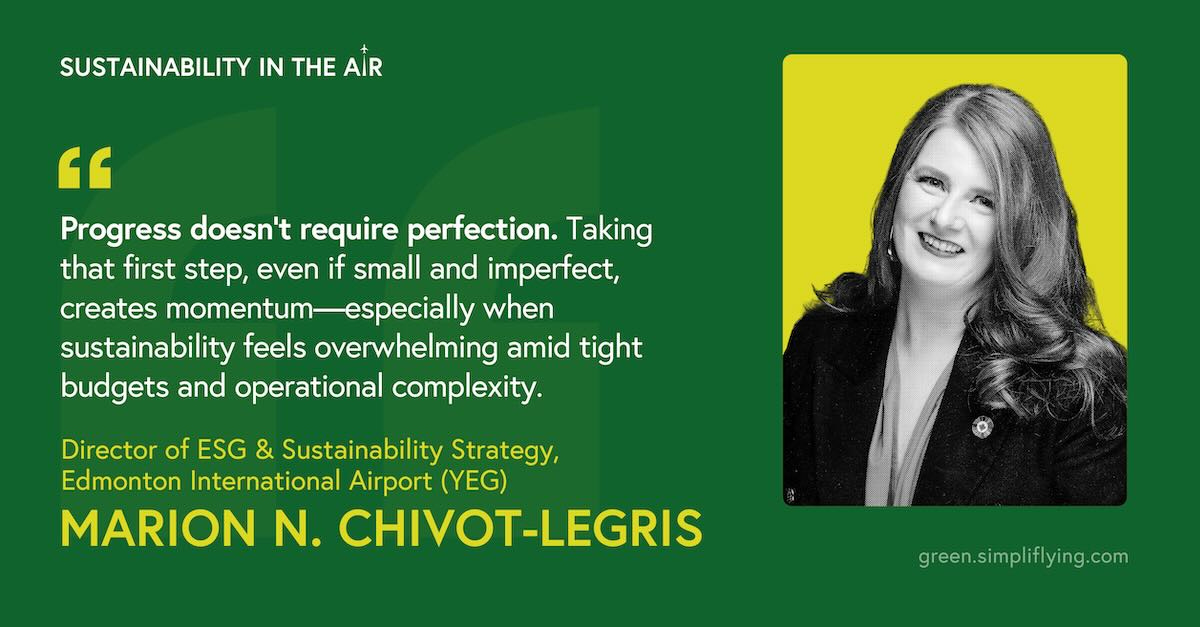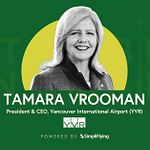In this episode of our ‘Sustainability in the Air’ podcast, Marion N Chivot-Legris, Director of ESG & Sustainability Strategy at Edmonton International Airport (YEG), speaks with SimpliFlying’s CEO Shashank Nigam about how the airport is leveraging its unique position to drive sustainability innovation across an entire region.
As Canada’s fifth-busiest airport by passenger traffic but the largest by land area (spanning 7,000 acres), YEG is reimagining what an airport can be—evolving from a transportation hub into a sustainability ecosystem. From trialling hydrogen-powered ground vehicles to fostering an agri-food ecosystem, the airport seeks to become a “sustainability engine” for the region.
Here are the key highlights of the conversation:
Why a holistic sustainability strategy matters for airports (2:42)
Building a hydrogen ecosystem from the ground up (16:09)
The complementary role of sustainable aviation fuel (20:03)
Transforming airport land into a sustainability campus (25:09)
Engaging partners to tackle Scope 3 emissions (30:57)
Community initiatives: From bees to drone deliveries (36:37)
Rapid Fire! (40:50)
Keep reading for a detailed overview of the episode.
How geographic advantage aids YEG’s sustainability goals
Located within Alberta’s energy heartland, YEG benefits from a strategic position that supports wide-ranging sustainability efforts. Its 7,000-acre footprint, proximity to Canada’s hydrogen corridor, and surrounding prairie landscape offer YEG unique conditions to develop initiatives that would be difficult to replicate elsewhere.
For airports, sustainability extends far beyond reducing carbon footprints. It requires reimagining infrastructure, fostering partnerships, and addressing social impact—a challenge YEG embraces through its Airport City Sustainability campus.
“We’ve created an airport sustainability campus that brings together clean energy companies, logistics, agri-food technologies, and education into one integrated ecosystem,” says Chivot-Legris. “It’s not just about aviation — it’s about building a future where ESG and economic growth advance together, hand in hand.”
The airport has leveraged its space to create a small city of sorts, featuring a mall, two hotels, a Costco, a casino, and even a golf course. More significantly, the land hosts innovative agricultural initiatives like hemp farming—a crop that requires minimal pesticides and water while efficiently capturing carbon—demonstrating how airport land can serve multiple environmental purposes beyond aviation.
5 takeaways from the conversation
1. Systematic carbon reduction through incremental improvements
YEG has made structured, measurable progress in carbon reduction, earning Level 2 certification in the globally recognised Airport Carbon Accreditation (ACA) programme.
“To get there, we had to meet all Level 1 requirements—mapping our full carbon footprint, creating a GHG inventory, and putting management systems in place,” says Chivot-Legris. “Level 2 has gone even further: we had to set targets, manage carbon effectively, and prove we’ve reduced emissions year over year.”
This achievement has resulted from sustained efforts across building systems, energy efficiency, and team engagement. Two standout projects have included a 4.5-megawatt cogeneration plant, commissioned in 2021, and a seven-year terminal-wide LED retrofit. The cogeneration system has supplied both power and heat by capturing waste energy, significantly reducing reliance on traditional heating.
Chivot-Legris has also emphasised the need to balance certifications with tangible results. “Disclosure isn’t performance,” she notes. “Frameworks help, but we’ve needed to focus efforts where they make sense.” Her team’s guiding principle: invest for meaningful results—“bang for the buck.”
YEG has now set its sights on Level 3 accreditation, which involves working beyond its own operations. “We’ve shifted focus to bringing our partners—airlines, tenants, ground handlers—into the process,” she says. “Sustainability at this scale has required collective action.”
2. Hydrogen development in Canada’s energy corridor
Rather than treating hydrogen as a distant solution, YEG has taken a phased, hands-on approach to building real-world capability. YEG currently operates hydrogen-powered Toyota Mirai and Hyundai Nexo vehicles, including airside inspection units, to build operational knowledge and safety protocols. Temporary hydrogen fuelling stations at its operations facility have supported this early adoption, allowing the airport to test refuelling procedures, train staff, and refine regulatory practices.
The airport has recently advanced to heavier equipment, converting two runway sweepers to hydrogen-diesel dual-fuel systems in partnership with Diesel Tech Industries.
Though hydrogen aviation remains a long-term goal—requiring new infrastructure, regulations, and training—YEG’s leadership is grounded in its role within the Edmonton Region Hydrogen Hub, where it now plays a central role. The partnership aims to scale Canada’s hydrogen economy, with the airport serving as a real-world test bed.
3. Building a sustainability ecosystem through strategic partnerships
YEG has developed a robust sustainability ecosystem through its Airport City Sustainability Campus—home to over 30 companies and 300 jobs. The initiative reflects YEG’s belief that complex climate challenges require collective effort across diverse sectors. This collaborative environment encourages innovation that isolated efforts can’t achieve.
“You need a whole ecosystem moving together to create meaningful change,” Chivot-Legris emphasises.
YEG also applies this model to sustainable aviation fuel (SAF), partnering with regional players like SixRing and FORGE Hydrocarbons to explore scalable, certifiable SAF production. While Canada currently lacks large-scale capacity, these efforts are helping lay the groundwork.
Rather than seeing SAF and hydrogen as competing technologies, YEG treats them as complementary—SAF for long-haul flights, hydrogen for regional routes. “They each have a role in aviation’s transition,” says Chivot-Legris.
This integrated approach includes regulatory advocacy. YEG collaborates with other Canadian airports, fuel producers, OEMs, and regulators to push for policy frameworks that support SAF deployment. “Everyone has to move the needle together to accelerate SAF integration.”
4. Biodiversity and social innovation
YEG has broadened its sustainability focus to include biodiversity and social impact, adopting a holistic approach that goes beyond carbon reduction.
The airport has introduced 50,000 bees to the airport grounds through partnerships with Alvéole (a certified B Corp) and the Alberta Beekeepers Commission. The project supports biodiversity, fosters ecological awareness, and creates educational opportunities. The initiative has sparked strong interest among passengers, staff, and the local community—so much so that the airport now produces its own honey for corporate gifting.
On the social front, YEG became Canada’s first airport to integrate drone logistics in 2021, launching scheduled commercial drone deliveries by 2022 within controlled airspace. The program reduces last-mile emissions while addressing urgent community needs. “These drones deliver high-value and medical goods to the Montana First Nation medical clinic, just nearby,” Chivot-Legris explains.
5. From small steps to system shifts
Perhaps the most valuable insight from Edmonton Airport's sustainability journey is the importance of progress over perfection and transparent communication about both successes and challenges. This approach has allowed YEG to make meaningful advances without becoming paralysed by the enormity of sustainability challenges, says Chivot-Legris.
This philosophy is complemented by a commitment to open communication about the airport’s sustainability journey, recognising that transparency builds trust and encourages collaboration.
“We shouldn't wait until everything is perfect to communicate. Sharing our story can inspire others and bring in new allies or new solutions, new partners that can just support your efforts,” says Chivot-Legris.
This emphasis on realistic progress extends to how the airport approaches partnerships, recognising the complementary strengths different organisations bring. “No single airport can decarbonise aviation alone. It’s unrealistic. We’ve made the most progress when we worked with others, like governments, airlines, academia, peers, and especially for Edmonton Airport Indigenous communities.”
‘Sustainability in the Air’ is the world’s leading podcast dedicated to sustainable aviation. Through in-depth conversations with top aviation leaders, we break through the clutter and provide a clear roadmap for a net-zero future.













